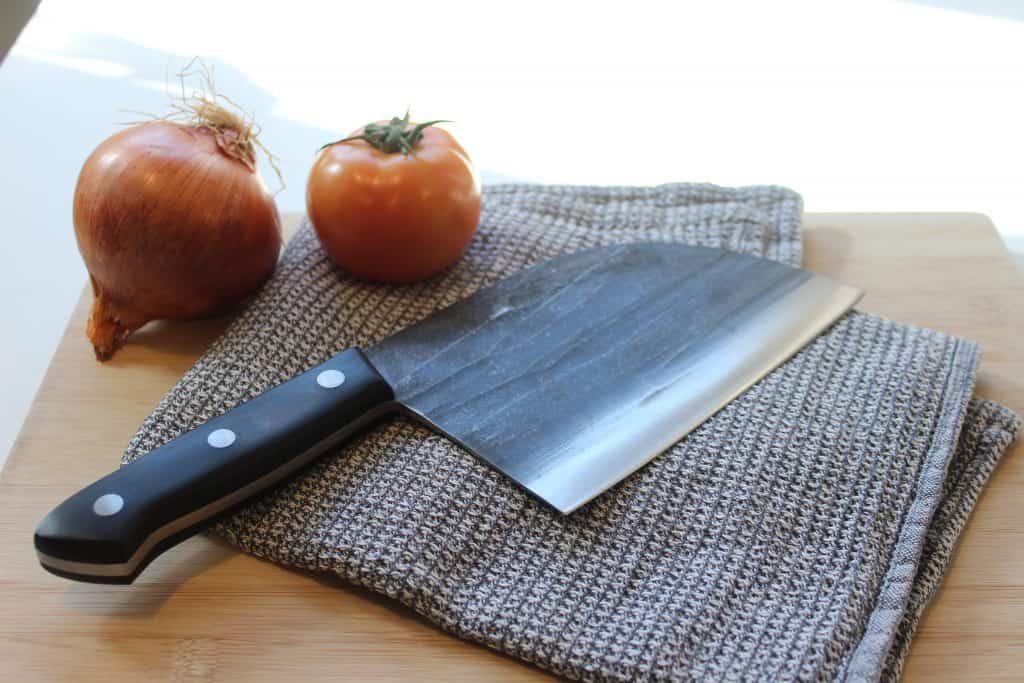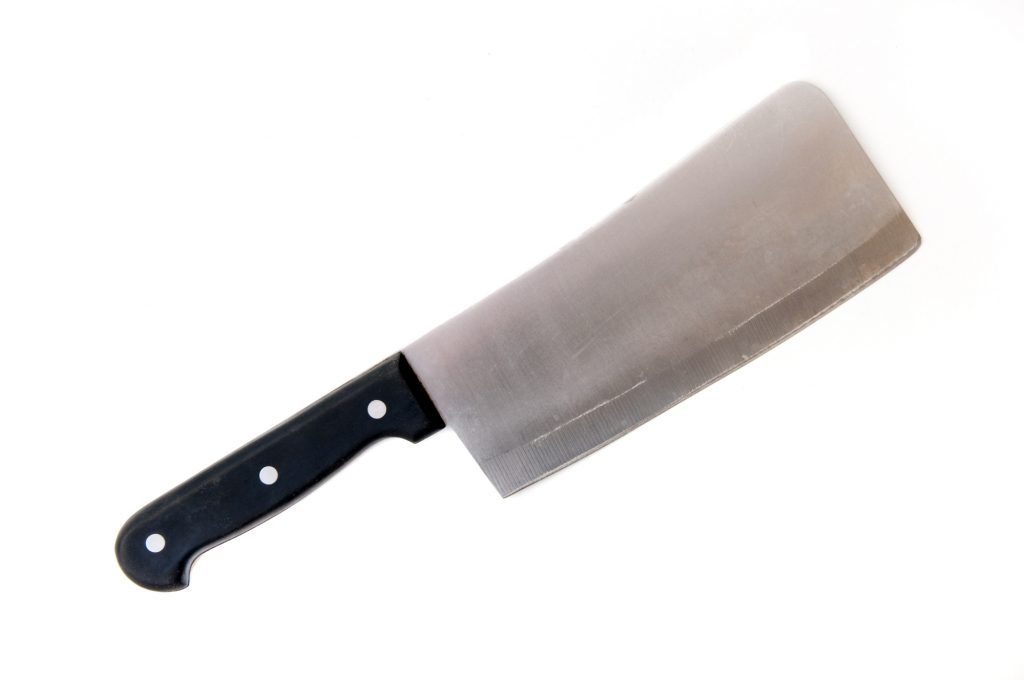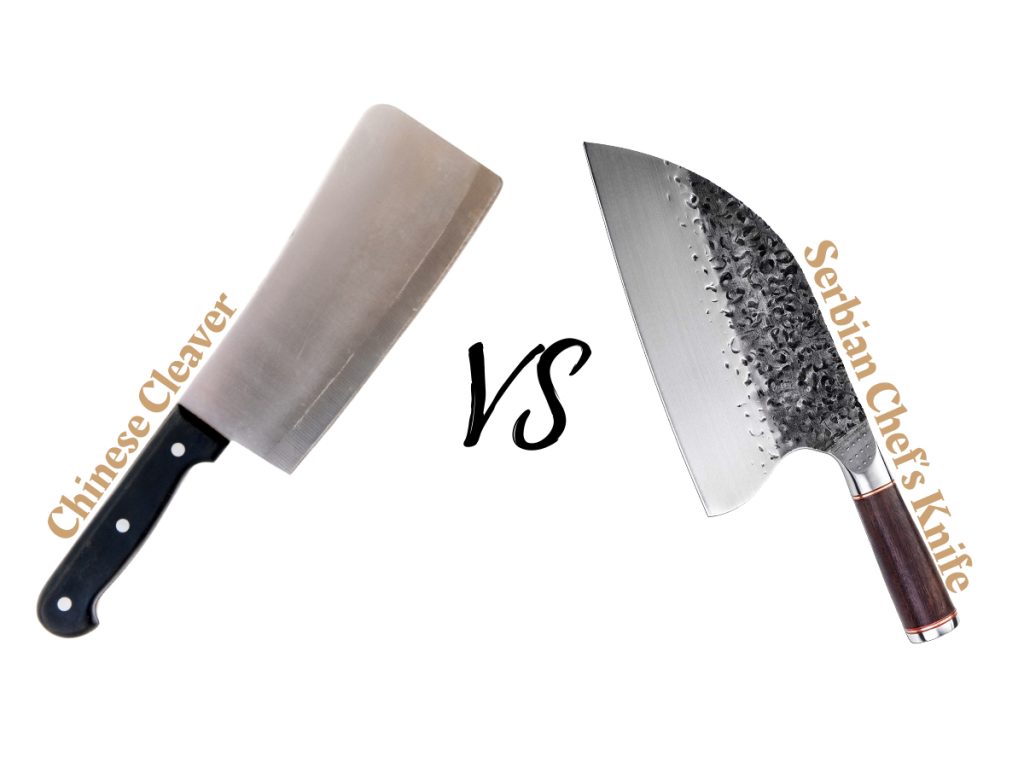Both Serbian chef’s knives and Chinese cleavers can be excellent kitchen companions in the right pair of hands. Both offer levels of versatility and sharpness that are more than enough to replace your western chef’s knife. The question is, what’s the difference between the two?
In this article, we’ll be discussing the Serbian chef’s knife VS Chinese cleaver debate. We’ll explore the use of each knife, what makes them different from each other, and how to know which one is right for you.
Serbian Chef’s Knife Overview
With relatively long, thick, and tall blades, Serbian chef’s knives call for an up-and-down motion when chopping. The end of the blade on Serbian chef’s knives curves to a sharpened point that can be used to make incisions or start cuts.
If you’ve never used one before, you’re in for a real treat – they can be fantastic kitchen tools!

Carbon Content
One defining characteristic of this kind of knife is its high carbon content. Most Serbian chef’s knives are made from high-carbon steel that’s formed through a repeated process of hammering and cooling. This allows for a blade that is stronger, firmer, and razor-sharp.
Just keep in mind that it may be more prone to chips than your other kitchen knives.
Sharpness Retention
Another big benefit of high-carbon steel is its sharpness retention. A higher carbon level generally means a higher HRC which in turn allows for a sharp edge that stays sharp for significantly longer.
Don’t be surprised if your Serbian knives need sharpening less often than you’re used to.
Read now >> How to test knife sharpness?
Meat Prep
A great deal of traditional Serbian food involved the preparation of raw meat in the kitchen. For this reason, many Serbian chef knives feature a convenient hole in the blade for extra grip while cutting.
Serbian Chef’s Knife Uses:
- Slicing, dicing, mincing, basic kitchen prep
- Preparing raw or cooked meats
- Tasks that require durability
- Tasks that call for higher sharpness
Serbian Chef’s Knife Basic Stats:
- Blades between 5 and 8 inches (usually 7)
- Blades typically 0.1” – 0.3” thick
- Between 57 and 62 HRC (typically higher for good quality options)
Chinese Cleaver Overview
The shape of Chinese cleavers is probably the first thing that sticks out to most shoppers. Its blade is rectangular, tall, and features a completely blunt/ sheer tip. They’re excellent at handling meat and softer bones but are also far more versatile than you might expect.
Anything from veggie prep to delicate slicing work is all a breeze with a good Chinese cleaver!
Chinese Cleaver Shape

Crushing a ton of garlic? Slicing through super tall veg or other foods? The large rectangular blade of a Chinese cleaver will be the perfect companion. Just keep in mind that there’s something of a learning curve to adapt to here if you’ve only ever used a western-style knife before.
The shape and size of these knives might take a bit of practice.
Chinese Cleaver Balance
Both Serbian chef’s knives and Chinese cleavers come with a different kind of weight distribution than many westerners will be used to. This difference is usually more pronounced with Chinese cleavers.
Again, it’s not rocket science to get used to but it might take a few tries before you’re comfortable with your new knife.
Chinese Cleaver Hand Position
As with Serbian knives, Chinese cleavers are best used with an up-and-down motion when chopping. An extra level of difficulty here is added by the height of the handle/ blade. It’s nothing you won’t be able to adapt to but it’s certainly worth keeping in mind.
Chinese Cleaver Uses:
- Slicing denser raw meat
- Cutting softer bones (with some force)
- Prepping veggies and herbs
- Conveniently ‘scooping’ up your chopped foods with the large blade
Chinese Cleaver Basic Stats:
- Blades 6-9 inches long and 3-5 inches high
- Usually 0.07” – 0.31” blade thickness
- 59-62 HRC
Serbian Chef’s Knife VS Chinese Cleaver – Key Differences
The main differences between Serbian chef’s knives and Chinese cleavers are appearance, blade thickness, flexibility, and overall sharpness. Both make excellent chef’s knives, but it’s worth keeping these differences in mind.
A Serbian chef’s knife offers a slightly thicker, sharper, less flexible blade overall. The hammered appearance of most options on the market will make a welcome addition to most kitchens.
A Chinese cleaver features a taller, thinner blade with a touch more flexibility. Its larger surface area is great for scooping up prepped foods and transferring them to the pan for cooking.
Overview
| Knife | Chinese | Serbian |
| Blade Length | 6-9 inches | 5-8 inches (usually 7) |
| Blade Thickness | 0.07- 0.31 inches | 0.1- 0.3 inches |
| Flexibility | Moderate | Low |
| HRC | 60-62 (but depends on the manufacturer) | 57-62 (usually higher) |
| Main Purpose | General kitchen prep, crushing and slicing veggies, softer bones, and meats. | Sharp, precise work. Raw meats, general kitchen prep. |
Flexibility and Sharpness
The specific stats here depend on the manufacturer you choose. That said, Chinese cleavers tend to be a touch more flexible than your average Serbian chef’s knife. A Serbian knife is also fantastic at maintaining its sharpness thanks to its high carbon content.
Thickness
On average, Serbian chef’s knives feature a slightly thicker blade. The variety of thicknesses available for Chinese cleavers is higher than average, but they tend to be slightly thinner than their Serbian counterparts.
Which One Should I Choose?
Preparing raw meat all day? Hate honing your knives constantly? We think you’ll love a Serbian chef’s knife.
Love the idea of a large surface area for crushing garlic or transferring foods to the pan? A Chinese cleaver is the way to go.
Chinese Cleaver Recommendation
Want a Chinese cleaver recommendation? We think it’s hard to go wrong with this one – Zwilling Twin Signature 7” Chinese Cleaver.
It feels fantastic in the hand and is super versatile.
The best Chinese meat cleavers.
Serbian Chef’s Knife Recommendation
In our opinion, the best Serbian chef’s knife on the market is this option – XYJ 6.7’’ Serbian Chef Knife.
We can’t get over how affordable it is!
Shop for the best Serbian chef’s knives.

Conclusion
We hope this page has helped you get to the bottom of the Serbian chef’s knife VS Chinese cleaver debate. While both options work great as chef’s knife alternatives, their flexibility and blade thickness are the main differences to consider.
Happy cooking!




Post Your Thoughts